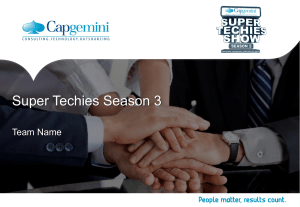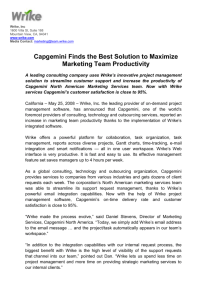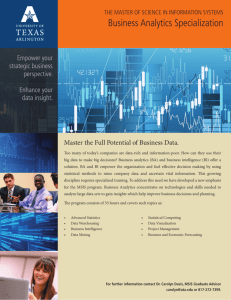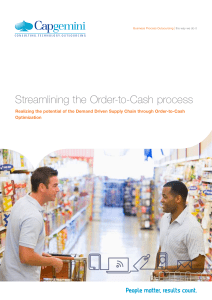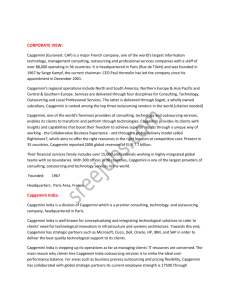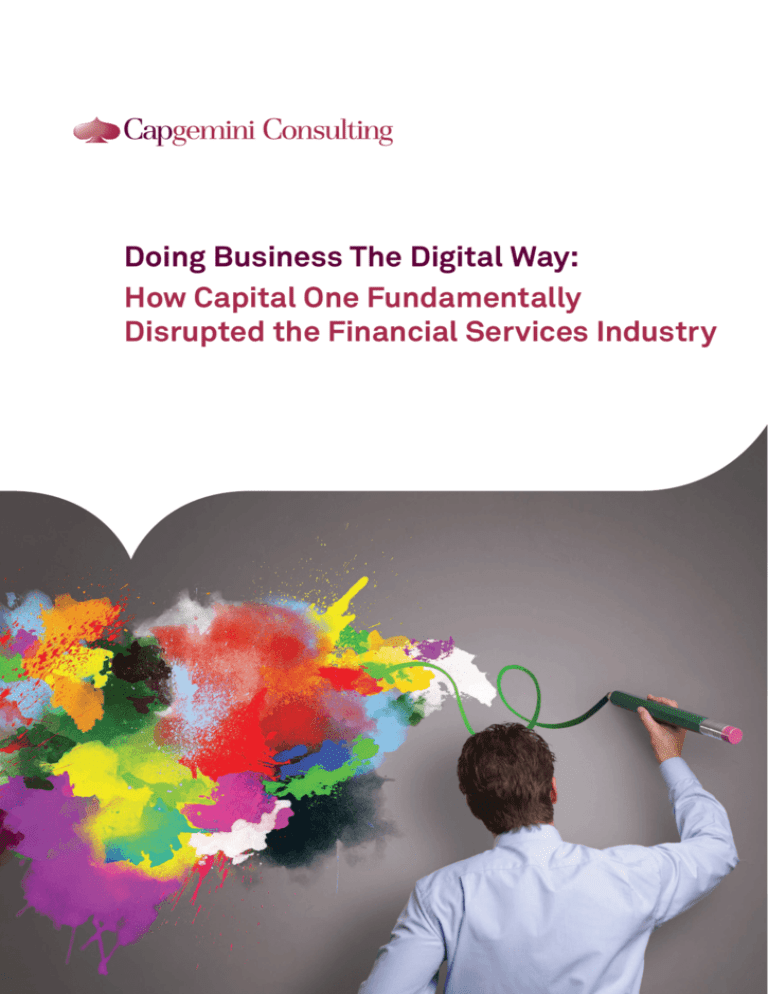
Doing Business The Digital Way:
How Capital One Fundamentally
Disrupted the Financial Services Industry
Capital One – Creating a Digital Bank
Here’s a quick exercise. What links these
different outfits: online bank ING Direct;
Bankons, a mobile startup that creates
geo-located offers; Bundle, a Citibank
spin-off that specializes in analysis of
spend data; Sail, a mobile point-of-sale
card-swiping device1? Here’s a hint – all
of these companies were acquired to
bolster the digital services of a leading
financial services organization. We are
talking about Capital One. Since its
founding as a credit card company in
1988, Capital One Financial Corp. has
grown into a diversified bank with more
than 65 million customer accounts
worldwide. It is not hard to see why
Capital One is investing heavily in digital
technologies. It conducts over 80,000
big data experiments a year2. Currently,
75% of customer interactions with
Capital One are digital, and this number
is only expected to grow3. In Q4 2013,
Capital One was one of the most visited
websites, with 40 million unique online
visitors4.
Capital One has fundamentally altered
traditional industry ways of working
through digital technology and has an
unflinching focus on digital. Chairman
and CEO Richard Fairbank has
reiterated that philosophy in a number
of statements, saying that “Digital is
who we are and how we do business5.”
He is very clear that digital is not about
cost reduction, saying “I think it’s a bit
of a fool’s errand and really off the bull’s
eye to chase digital for the sake of cost
reduction6”, and emphasizes how deep
digital goes at Capital One – “We need
to make digital how we do business not
only with our customers, but also how
we operate the company7.”
Digital is who we are
and how we do business.
- Richard Fairbank, CEO
This unrelenting focus on digital has
underpinned Capital One’s strong
performance. Despite the global
recession, Capital One has maintained
sector-leading growth and steady
profits. For instance, from 2005 to
2013, Capital One achieved a CAGR in
profit-before-tax of 10.78%, significantly
Capital One conducts
over 80,000 big data
experiments a year.
outperforming the CAGR of the top three
leading banks in the US (see Figure 1).
Despite this strong performance, the
bank is not resting on its laurels and
continues to innovate. In 2013, Capital
One introduced new digital enrollment
and card activation experiences to
migrate customers to digital services. It
also introduced pattern tracing, where
customers can trace a pattern on their
mobile phone instead of entering a
password. This makes it easier to use
their mobile application8 and to shop
and buy with a mobile phone. The bank’s
digital service culture is supported by
rapid prototyping capability, which
helps deliver new tech-based features
faster, as well as real-time analytical
tools. These digital capabilities are the
deliberate result of a long-term strategy
that Capital One has had in play over a
number of years, and which we look at in
the following section.
I think it’s a bit of a
fool’s errand… to chase
digital for the sake of
cost reduction.
- Richard Fairbank, CEO
Figure 1: Profit-Before-Tax and Comparative CAGR Analysis of Capital One and Peers
Comparative CAGR of Profit-Before-Tax (2005-2013)
Capital One vs Top 3 US Banks
Capital One — Profit-Before-Tax Growth, billion USD, 2005-2013
$6.4bn
$4.3bn $4.5bn
$3.6bn
$5bn
9.80%
10.78%
$3.8bn
$2.8bn
Citigroup
Bank of
America
$1.3bn
JP Morgan
$582mn
-4.66%
2005
2006
2007
2008
2009
2010
Source: Capital One, Citigroup, JP Morgan Annual Reports
2
2011
2012
2013
-5.05%
Capital One
Capital One’s “Information-Based Strategy”
Drives Mass Customization
As early as the ‘90s, Capital One was
quick to identify that there was little
differentiation in the credit card industry,
with its CIO, Robert M. Alexander,
noting that “It was a one-size-fits-all
pricing approach9.” This belief led to
the creation of an “Information-Based
Strategy”. The strategy combined the
power of information, technology and
testing to bring customized solutions to
consumers and help deliver “the right
product to the right customer, at the
right time and at the right price.” As the
CIO explains, “Essentially, what we were
doing in the ‘90s was leveraging the
power of data to custom-tailor products
to our customers. We ran thousands
of tests to learn about what customers
wanted10.”
Capital One formulated its digital
strategy on three key pillars – the use of
analytics, investment in digital talent and
restructuring the company’s IT workforce
to enable rapid development and
deployment of new innovative services
(see Figure 2).
Using Analytics to Target
Profitable Customers with
Personalized Offers
Analytics has always been the
cornerstone of Capital One’s business.
Since its inception, the bank has been
using sophisticated data collection
methods to tailor products and services to
individual customer needs. In the 1990s,
when most of the credit card industry
was characterized by uniform pricing,
Capital One’s founders used statistical
models based on publicly available credit
and demographic data. The objective
was to determine the best combination
of product, price and credit limit that
could be offered to its customers. For
example, as early as 1999, Capital One
received over a million calls per week
at its call centers. Before the call was
answered by an employee, high-speed
computers, which contained information
on one in seven US households, swung
into action. The analytics system
reviewed over 50 options to determine
Figure 2: Capital One’s Digital “Information-Based Strategy”
Insourced IT
Digital “Information
Based Strategy”
Big Data/
Analytics
Digital
Talent
Source: Capgemini Consulting
whom to notify and analyzed a range
of information about the person who is
calling. The system even predicted what
the caller might want to buy with greater
than 70% accuracy. All these steps
happened in under 100 milliseconds11.
This pioneering approach to analytics was
one of the cornerstones of Capital One’s
approach as it made strong inroads into
the market. The bank achieved growth
in both earnings per share and total
customers at a compounded annual rate
of 28% in the period 1994-2003. From
2000 through 2003, Capital One’s share
of the U.S. credit card market rose from
3.3% to 7.2%12.
Capital One used analytics not just for
predictive sales; it also used it effectively
to drive an increase in the customer
retention rate and a reduction in cost
of customer acquisitions. For instance,
the use of data on interest rates, rollover
incentives, special promotions and so
on has helped Capital One increase its
customer retention by 87%. It has also
lowered the cost of acquiring a new
customer by 83% over a period of 2-3
years13.
By using analytics to drive product
customization, Capital One has been
able to create several innovative service
offerings crafted to customer needs (see
Figure 3). For instance, the bank was the
first to introduce an innovative balancetransfer credit card. The card allows
customers of other banks to transfer
what they owed on higher-interest
cards to a Capital One card with a lower
introductory rate.
Capital One also introduced a rewards
redemption program called “Purchase
Eraser”.
The
program
allowed
consumers to repay the cost of previous
travel expenses using their reward miles.
The “Purchase Eraser” offer could be
redeemed across a variety of travel
expenses that include flights, cruises,
hotel stays and car rentals. The benefit
of the program was that it allowed
customers to take advantage of deals not
offered through in-house travel-booking
channels. For example, customers have
the dual benefit of combining discounts
offered through third-party websites
while also redeeming their miles through
the “Purchase Eraser” program. Capital
One also offered digital coupons through
a mobile app – “Mobile Deals” – which
3
could be accessed via a smartphone or
email. The coupons provided targeted
money-saving deals to card holders
based on their spending habits.
Driving Partnership
between IT and Business
to Deliver Products with
Increased Speed and
Efficiency
Early on, Capital One realized that IT was
a key determinant of success in a digital
world. Its CIO goes as far as to say, “For
financial services, our product is IT, in a
way. It’s an intangible product that we
deliver through IT solutions14.” However,
in delivering this intangible product, the
company understood that traditional
approaches to software development
could be a hindrance. In 2011, to achieve
greater business engagement – and
ensure their involvement with developers
through the lifecycle of the project –
the bank started to move 70% to 75%
of outsourced IT development work
in-house. Having the business team
involved with the IT development team
allowed the bank to monitor a product
along several metrics that include
quality, delivery time, cost and meeting
expectations on the first deployment.
These increased levels of collaboration
also foster the real-time problem solving
needed to rapidly innovate and deliver
new digital capabilities for customers.
Such an approach has led to the
development of the bank’s customerfacing software for capitalone.com,
with ongoing projects on smartphone
and tablet apps for an online portal for
commercial loan customers15.
Building a Digital Talent
Base to Drive In-House
Development
Its focus on analytics meant Capital
One needed to recruit analysts with
quantitative skills to assess complex
numbers and derive actionable insights.
While that skill set is scarce and difficult
to find, securing it formed a key element
of the Capital One IBS strategy. As
early as 2006 the bank was seeking to
hire three times as many analysts than
operations people16.
Moving development capabilities inhouse meant the bank needed to recruit
more engineering talent equipped with
mobile and software skills. As CIO Rob
Alexander said, “If digital is so central
to our strategy, we really need an IT
Figure 3: Capital One’s Mobile App Offerings
Capital One’s Digital Service Offerings
Purchase Eraser App
4
Mobile Deals Program
organization that is able to deliver like
a technology company, and not like a
traditional bank17.” To equip itself with
this talent, the bank acquired several
banking technology start-ups while also
recruiting new associates directly from
college and graduate school. In 2012
it acquired Bankons, a mobile start-up
that creates geo-located offers. The
acquisition allowed the bank to offer tools
that reward users based on their geolocation and their purchase history. The
bank also acquired data aggregator firm
Bundle Corp. The acquisition helped the
bank capitalize on Bundle’s proprietary
analytics technology powered by data
from more than 20 million Visa and
MasterCard branded cards18.
The bank beginning
in 2011 started to
move 70% to 75%
of outsourced IT
development work
in-house.
While acquisitions certainly helped
Capital One gain access to digital
talent, that was not its only route to
talent acquisition. Capital One has
an 18-month Information Technology
Development Program that gives new
associates the opportunity to work on
global-scale technology projects. The
exposure allows them to develop skills
needed to build new Internet, social
media and smartphone capabilities19.
A key element of getting the right talent
was the hiring process itself. And here,
as well, Capital One’s focus on analytics
is clear. The company administers
mathematical cases, a variety of
behavioral and attitudinal tests, and
multiple rounds of interviewing to ensure
it gets the people with the right fit. And
such an approach is followed across all
levels, right up to senior vice presidents
who head business functions20.
Creating a Differentiated Customer
Experience Through Digital
Capital One’s digital leadership is not
just confined to operations. It has also
successfully utilized various digital
platforms and technologies to transform
the customer experience.
Coordinating Online/Offline
Offerings With Café Styled
Branches
Starting in 2014, Capital One is
experimenting with a café format for
its bank branches, designed primarily
to drive services offered by their online
bank - Capital One 360. Across the US,
the bank has 9 café-styled branches that
provide high levels of customer intimacy
along with complimentary services21. As
well as providing access to financial and
digital tools, bank staff offer personalized
advice on saving and investing strategies
while also providing detailed information
on Capital One 360 products.
Creating Brand Awareness
and Customer Engagement
Through Social Media
Capital One is a strong proponent of
using social media and video to engage
with its customers. For instance, in
2012, the company sponsored the US
college football Capital One Bowl, with
the promotional hashtag trending on
Twitter throughout the matchup. The
initiative had around 120,000 people
vote via Twitter in a contest to name the
2012 college Mascot of the Year22. It also
launched a humour-driven web video
series to drive awareness for its mobile
banking offering.
Focusing on the Mobile
Channel to Exploit Future
Opportunities
Capital One has progressively extended
the capabilities of its mobile applications.
Its app, for example, allows customers
to make check deposits using their
smartphones. The bank’s digital brand
manager has said, “Mobile is really
blurring the lines between traditional
and digital channels and the bank is
really looking at how to use mobile
as an interactive piece23”. To achieve
this, Capital One is making a foray into
mobile payments. It is testing new user
experiences in the payments space,
such as paying with rewards at the
point of sale. It is participating in multiple
payments technology trials, such as
the NFC pilot and the QR code pilot
programs. And it recently introduced a
peer-to-peer payment service that allow
customers to exchange money with one
another using a bank-owned platform,
ClearXchange24.
Capital One has come a long way in
its digital journey. The company has
set several fundamental benchmarks
that its peers in the financial services
industry are now compelled to meet.
And this journey has only just started,
as its CEO states, “I think there is a lot
of work and a lot of challenging of our
own conventional wisdom to actually
truly now build a digital company25.” With
its radical digital approach, Capital One
is not just challenging its own wisdom,
but that of the entire financial services
industry.
Accelerating Innovation with Capital One Labs
Launched in 2011, the objective of the Capital One Labs is to develop digital products in collaboration with venture capitalists,
entrepreneurs and academics. The Labs launched a mobile card reader in 2013 called Spark Pay that lets merchants accept
payments on mobile devices. The Spark Pay reader integrated with a mobile and web app and is designed to help business
merchants execute tasks rapidly and access associated analytics. The platform’s current services include custom receipts, offers,
inventory management tools and sales report analysis.
The bank also holds regular meetings and competitions for young designers to encourage the creation of new products in less
than 24 hours. For example, in 2012, the bank held MoDevUX Hackathon, a competition for developers of mobile banking
applications.
There are three innovation labs, operating out of three tech hubs of New York, Washington D.C. and San Francisco. The labs
are intended to allow its team of developers to test new ideas without hampering other ongoing projects. In order to encourage
innovation across the wider enterprise, Capital One rotates developers through thelabs.
The labs use an integrated set-up with teams of three people consisting of a business analyst, an engineer and a designer.
This combination is designed to ensure that concepts become tangible and real in about two to three weeks. As CTO Monique
Shivanandan says, “We combine technology people, data analysts, marketing people, brand managers and product managers
in the labs to be sure we’re focused not just on cool technology but innovative products and services to delight the customer.”
Source: Computer World, “How enterprise IT gets creative”, June 2013
5
References
1
American Banker, “On Capital One’s Drawing Board: Data Tools for Small Businesses”, February 2014
2
Sogeti, “Your Big Data Potential”, 2013
3
Capital One Annual Report, 2013
4
Capital One, “2014 Annual Stockholder Meeting”, May 2014
5
Bank Innovation, “Capital One CEO: ‘Digital Is Who We Are and How We Do Business’”, December 2013
6
Seeking Alpha transcript of Capital One Q4 2013 earnings call
7
Seeking Alpha transcript of Capital One Q4 2013 earnings call
8
Mobile Commerce Daily, “Capital One introduces pattern tracing to simplify mobile banking log-ins”, November 2013
9
UVA Today, “Capital One CIO Talks Big Data, Innovation Ahead of Tonight’s Information Session”, January 2014
10 UVA Today, “Capital One CIO Talks Big Data, Innovation Ahead of Tonight’s Information Session”, January 2014
11 Fast Company, “This is a Marketing Revolution”, April 1999
12 The Motley Fool, “Capital One Rolls With the Punches”, March 2005
13 Thomas H. Davenport and Jeanne G. Harris, “Competing on Analytics: The New Science of Winning”, 2007
14 Computerworld, “The Grill: Capital One’s CIO discusses business strategies for tough financial times”, November 2008
15 Information Week, “Capital One Digital Strategy Drives IT Overhaul”, March 2014
16 Harvard Business Review, “Competing on Analytics”, 2006
17 Information Week, “Capital One IT Overhaul Powers Digital Strategy”, April 2014
18 Forbes, “Capital One Buys Data Analytics Firm To Tap Spending Trends At Local Businesses”, June 2012
19 UVA Today, “Capital One CIO Talks Big Data, Innovation Ahead of Tonight’s Information Session”, January 2014
20 Thomas H. Davenport, Jeanne G. Harris, “Competing on Analytics: The New Science of Winning”, 2007 accessed through
Google Books
21 Company website, accessed in May 2014
22 Socialnomics, “5 Companies on Top of Social Media”, August 2013
23 Mobile Marketer, “Capital One exec: Mobile is interactive piece that bridges traditional, digital channels”, December 2012
24 The Paypers, “Capital One to enable peer-to-peer money transfers via e-mail, mobile devices”, March2014
25 Seeking Alpha transcript of Capital One CEO’s presentation at Goldman Sachs Financial Services Conference,
December 2013
6
Authors
Jerome Buvat
Head of Digital Transformation
Research Institute
jerome.buvat@capgemini.com
Subrahmanyam KVJ
Manager, Digital Transformation
Research Institute
subrahmanyam.kvj@capgemini.com
Digital Transformation
Research Institute
dtri.in@capgemini.com
The authors would also like to acknowledge the contributions of Aparna Gajanan from the Digital Transformation Research Institute.
For more information contact
Didier Bonnet
didier.bonnet@capgemini.com
Jerome Buvat
jerome.buvat@capgemini.com
About Capgemini and the
Collaborative Business Experience
Capgemini Consulting is the global strategy and transformation
consulting organization of the Capgemini Group, specializing
in advising and supporting enterprises in significant
transformation, from innovative strategy to execution and with
an unstinting focus on results. With the new digital economy
creating significant disruptions and opportunities, our global
team of over 3,600 talented individuals work with leading
companies and governments to master Digital Transformation,
drawing on our understanding of the digital economy and
our leadership in business transformation and organizational
change.
With more than 130,000 people in over 40 countries, Capgemini
is one of the world’s foremost providers of consulting,
technology and outsourcing services. The Group reported 2013
global revenues of EUR 10.1 billion. Together with its clients,
Capgemini creates and delivers business and technology
solutions that fit their needs and drive the results they want. A
deeply multicultural organization, Capgemini has developed its
own way of working, the Collaborative Business ExperienceTM,
and draws on Rightshore®, its worldwide delivery model.
Learn more about us at www.capgemini.com
Find out more at: www.capgemini-consulting.com
Rightshore® is a trademark belonging to Capgemini
Capgemini Consulting is the strategy and transformation consulting brand of Capgemini Group. The information contained in this document is proprietary.
© 2014 Capgemini. All rights reserved.



